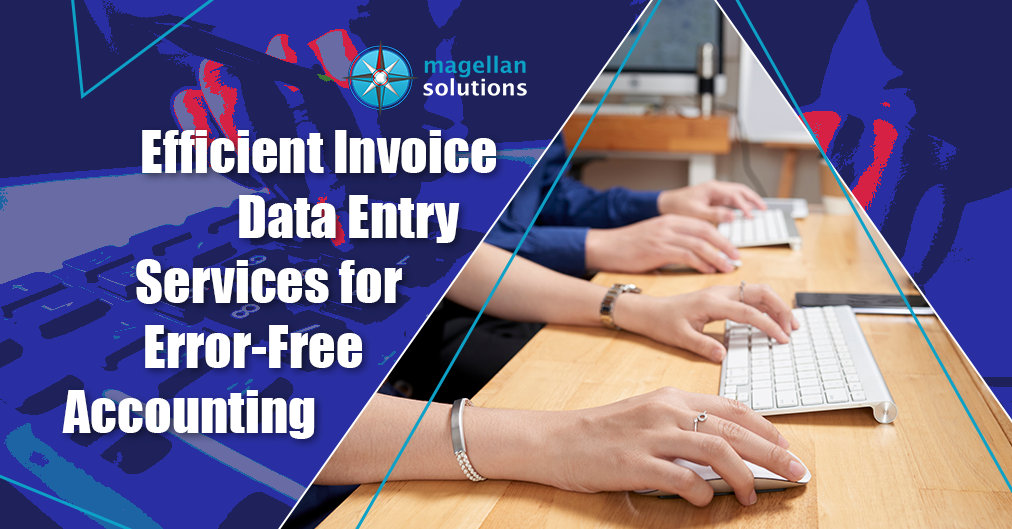Schedule a FREE call with our outsourcing expert now and get a precise quotation that meets your requirements. Don't wait - get started today!
Invoice data entry services are vital for any business. However, it’s also a major pain point—especially when done manually. Don’t be shocked by repetitive data entries, incorrect dates, and other missing information. The result? Delayed payments, strained supplier relationships, and operational inefficiencies.
It’s no surprise, given over 60% of enterprises struggle with capturing and processing their invoice data—wasting up to 9 days per month on repetitive manual tasks just to keep up with invoices. The smart choice to deal with this is to outsource the work to established invoice data entry specialists. The goal is to drive higher productivity and error-free accounting.
Keep reading as we explore the ins and outs of invoice data entry services and analyze strategies businesses can leverage to enhance efficiency.
How Invoice Data Entry Services Work
Efficient invoice data entry services play a crucial role in helping businesses maintain accurate and error-free accounting records. To understand how these services operate, let’s take a closer look at the step-by-step process involved:
Step 1: Receiving Invoices – Billing invoices are received from external suppliers, vendors, contractors, and clients in physical or digital formats.
Step 2: Document Scanning – Invoices received in physical formats may need to be scanned to convert them into digital documents. Scanning is the first step in the data entry process for paper invoices.
Step 3: Extracting Invoice Data – Once invoices are in digital format, advanced optical character recognition (OCR) technology is often used to extract document data. OCR software identifies and converts printed or handwritten text on the invoices into machine-readable data.
Step 4: Data Validation – Extracted data is subjected to thorough validation. This step involves checking for any discrepancies, errors, or missing information. Additionally, validation ensures that the data entered accurately reflects the information on the invoices.
Step 5: Data Entry – The extracted and verified invoice data are logged into the business’ accounting software programs and financial databases. Manual inputting of data is usually done, so accuracy in capturing invoice details is essential.
Step 6: Data Integration – The entered invoice data is integrated into the business’s accounting system. This integration ensures that the financial records are up-to-date and accurate, thus providing a comprehensive view of the company’s financial status.
Step 7: Financial Reporting – Businesses can generate various financial reports using accurate data after the data entry and validation process. These reports help make informed decisions, track expenses and assess the company’s financial health.
Common Invoice Data Entry Services Challenges
One of the reasons why businesses consider outsourcing their invoice data entry services is to enhance quality and minimize errors. Here are some of the challenges that invoice data entry faces:
1. Missing Information
Incomplete or unclear invoices often lack critical information, such as vendor details, purchase order numbers, or item descriptions. This can slow down the data entry process and require additional follow-up with suppliers.
2. Diverse Invoice Formats
Invoices come in varying formats like PDFs, scanned copies, photos, and paper documents with no standard template. This diversity and lack of structure pose a challenge in data extraction.
3. Time-Consuming Process
Manual data entry is time-consuming, especially for businesses with high invoices. This is one of the causes of delays in processing and payments.
4. Legacy Systems
Older accounting or data entry systems may not support automation or have limited capabilities, making it harder to streamline the process.
5. Compliance and Audit Trail
Maintaining a proper audit trail for invoices, including data entry, approvals, and payment records, is essential for compliance and can be challenging to manage manually.
6. Data Validation
While technologies for automating data extraction have advanced considerably, research shows that 68% of businesses continue to use manual data entry. This remains a persistent challenge, especially when large volumes of invoices need to be validated.
Strategies to Overcome These Challenges
To overcome these challenges and ensure that invoice data entry services operate smoothly and effectively, businesses and outsourcing providers should consider implementing the following strategies:
Strategic Outsourcing Partnerships
- Assess the outsourcing provider’s experience in handling invoice data entry tasks.
- Verify that the outsourcing provider has a robust IT infrastructure and up-to-date data security measures.
- Assess the outsourcing provider’s flexibility in adapting to your unique invoicing processes. They must be able to assist you in automating processes, especially if you’re still using the traditional way of doing things.
Standardize Invoices Upfront
- Encourage suppliers to provide invoices in a consistent format that is easy to process.
- Utilize Optical Character Recognition (OCR) technology to digitize unstructured format to convert unstructured invoice data into a digital, structured format.
- Use automation to ensure that invoices submitted by suppliers meet predefined standards and formats.
Simplify Workflow Processes
- Streamline approval processes by removing unnecessary steps.
- Assign responsibility to individuals who oversee the invoice processing cycle to enhance accountability and significantly ensure a smooth workflow.
- Set clear Service Level Agreements (SLAs) to establish clear expectations for processing times, especially regarding turnaround times.
Improve Access and Visibility
- Digitize and store all invoices in a central repository for easy access and retrieval.
- Provide remote access to invoices, allowing stakeholders to view and work on them from anywhere.
- Ensure that all involved parties have visibility into the invoice processing workflow and status.
Incentivize Supplier Onboarding
- Educate suppliers on the advantages of electronic invoicing, such as faster processing and reduced errors.
- Offer assistance, training, and resources to help suppliers transition to electronic invoicing.
- Incentivize suppliers by offering benefits or incentives for consistently delivering accurate and timely invoices.
Invest in Automation and AI
- Use automation to handle routine and straightforward invoice processing tasks from start to finish.
- Utilize Artificial Intelligence and Machine Learning to intelligently route invoices and validate data to reduce manual intervention.
- Free up human resources to concentrate on handling exceptions, building supplier relationships, and strategic tasks.
Digitize Your Invoices with Magellan Solutions!
After 18 years of streamlining operations for SMEs, Magellan Solutions knows the pains of paper invoices all too well. Misplaced documents, costly errors, wasted time—we’ve seen it all!
As a trusted partner for nearly two decades, Magellan Solutions has the experience to implement invoice data entry services digitization seamlessly across your financial workflows. And with plans scaled for any business size, going digital won’t break the bank.
Say goodbye to paperwork. Contact Magellan Solutions today to start digitizing your invoices.













